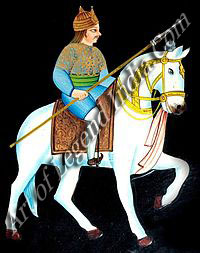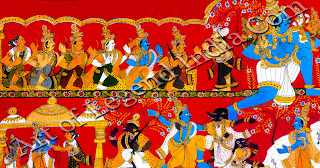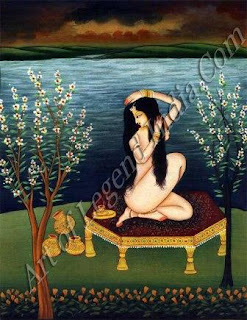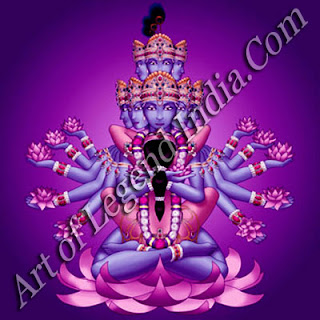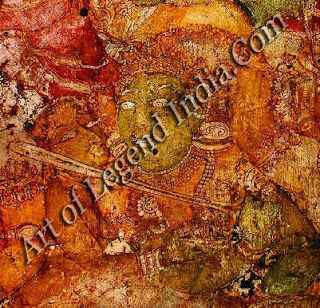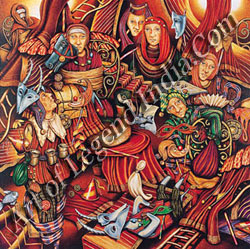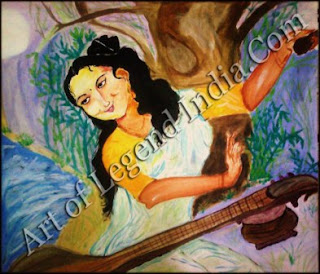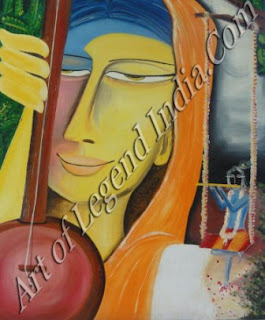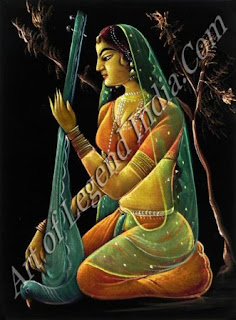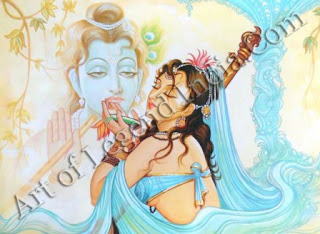
Although
at about the time of the successive waves of Aryan conquest the Indus Valley civilization retreated, with remnants only in villages by 1700 B.c., the
changes that took place with the Aryan invasions should not be exaggerated. The
transition may have been gradual rather than cataclysmic. Though it is true
that the Aryans conquered with bronze weapons, bronze was known at Harappa, and
the so-called copper-hoard culture in which copper tools were used existed in
northern Indian village-based agricultural settlements in such areas as Madhya
Pradesh from the second millennium B.C. Its connection with the Indus Valley
civilisation and its successors is still unknown. It was the use of iron
tools, however, that was decisive for the supremacy of the Aryans in northern
India. Iron was introduced about 1370-1050 B.C. and it coincided with the
Aryans' spread into the Jumna and Upper Ganges valleys. Their settlements there
were to develop into cities by about Goo B.C. These cities were surrounded by
massive fortifications and became the nucleus of empires centred in Magadha
(modern Bihar).
At the
time of their arrival in India, however, the Aryans had no know-ledge of city
life; indeed their chief god, Indra, was vaunted as 'destroyer of cities'. They
were a warrior people of relatively low culture who in previous migrations had
spread from the west, probably the Urals, into the Central Asian steppes. They
remained illiterate for several centuries after reaching India, and the lack of
extant works of art (they used wood rather than stone) further impoverishes our
record of them. But we know they were light-skinned, hard-drinking folk, whose
mastery of horses and chariots and whose use of sword brought them swift
victory over tilt Dravidians, whom they accordingly despised as `Dasyus', or
dark. skinned.
The
Aryans brought with them their own religion, which for sonte seven centuries
dominated the nord. Indian scene. Aryan beliefs and mythology were far from
static, however gradually adapting to Indian conditions, absorbing native
cultural traditions, and ultimately evolving into Hinduism. Unlike the
conquered Dravidians, the Aryans had never previously settled for long; their
godt were connected less with the soil or which they lived than with the
universal elements. Our direct knowledge of these gods stems from the Vedas,
collections of hymns which seem to have been completed by about the tenth
century B.C. By thittime, however, the Aryan pantheon had acquired considerably
more sophistication, despite its retention of the earlier elements, and the
accom panying mythology reflected moral preoccupations and a divine hierarchy.
Varuna
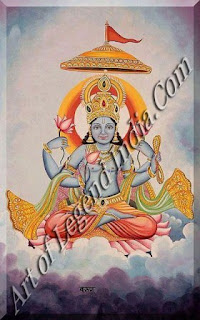 Relatively
few Vedic hymns are addressed to Varuna, though he is the guardian of the
cosmic law and the universal monarch, the object of greater veneration than the
more ob. viously Aryan deities. Vanilla is the Prime Mover of the universe. He
is pictured first as creating the universe. Standing in the air, he exercises
his creative will, or maya, and using the sun as his instrument he measures out
and so gives form to the three worlds: the heavens, the earth, and the air
between them.
Relatively
few Vedic hymns are addressed to Varuna, though he is the guardian of the
cosmic law and the universal monarch, the object of greater veneration than the
more ob. viously Aryan deities. Vanilla is the Prime Mover of the universe. He
is pictured first as creating the universe. Standing in the air, he exercises
his creative will, or maya, and using the sun as his instrument he measures out
and so gives form to the three worlds: the heavens, the earth, and the air
between them.
Vanilla's
creative activity is also continuing: again by exercise of his maya, hecauses
rain to fall and rivers to flow and thus sustains his creatures. His breath is
the wind. In a sense he is embodied in his creation, or at least omnipresent in
it, for he surveys it continuously with the sun as his eye, and he himself
props up the heavens. Alternatively he is thought to be seated majestically in
his thousand-columned, thousand-doored gold palace in the sky surrounded by his
ever-watchful spies, one of whom is the sun itself which daily rises to
Varuna's mansion at the zenith and reports on what it sees. Varuna's function
is thus moral even more than it is creative: his maya is equally the principle
of truth or justice and the god thus has the priest-like function of judging
his creatures. He evaluates their actions against rta, laws unknowable to human
beings. Varuna nevertheless punishes people who transgress these laws, and for
this purpose he carries a rope with which to tie them up, symbolic of the sins
with which they fetter themselves in their ignorance. Humans cannot know how
they come to find them-selves guilty, for Varuna's ordinances are inscrutable;
they have to fall back on fear, the hope of forgiveness, and extreme
circumspection in all their dealings with the god.
Varuna
kept his elevated position for a relatively short time; one by one the
attributes for which the great 'universal encompasser' was revered passed to
other gods. Two distinct stages of this development had already occurred by the
close of the Vedic age. The first change was introduced when Varuna became one
of what was perhaps the first of India's long series of divine triads. This
triad was composed of Varuna, Mitra and Aryaman. Mitra was in most ways similar
to Vanilla and like him could bind humans with their sins, petitions to the two
gods being the sole hope of forgiveness; but Varuna's realm of jurisdiction was
split, Mitra be-coming guardian of the day, while Varuna's part was reduced to
the guardianship of the night. Aryaman's functions are ill-defined but he must
also have been a god of the heavens for the triad was known as the Adityas, or
Celestial Deities, who, like Varuna alone, were credited with being the source
of all heavenly gifts, the regulators of sun and moon, winds and waters, and of
the seasons. Mitra in particular was therefore considered as a corn god or
fertility god.
The
second change in Varuna's status came when the Adityas, until then known as the
asuras (like the Iranian ahuras) were joined by three or by nine other gods,
who ranked among the devas, of whom Indra was to be-come leader. (Another
branch of the Aryans reached Iran about 1000 B.C., where their gods developed
along different lines.) The changed member-ship of the group brought a change
in function, and the Adityas became no more than minor gods representing the
sun in its twelve annual phases. Meanwhile the idea of a divine triad was
perpetuated with figures from the Aryan pantheon: Vayu (wind), Agni (fire) and
Surya (the sun); or Indra, Agni and Surya.
Prithivi and Dyaus
Prithivi,
the earth, and Dyaus, the sky or heaven, were symbolised as cow and bull. They
were early deities, worshipped as fertility gods and thought to have engendered
all the other gods and men. Their importance diminished, however, and though
they survived into later pantheons their progeny was much reduced. Ushas, the
dawn, was their daughter and Agni, fire, their son. But their greatest claim to
fame is through Indra. Prithivi was the 'heroic female' and Dyaus the 'vigorous
god' who were Indra's parents. At the time of lndra's birth from Prithivi's side
the heavens, earth and mountains began to shake and all the gods were afraid.
Prithivi herself was fearful and hid her son and gave him no attention. None of
the gods would come to the infant's aid for they all felt, as was indeed the
case, that this child was the herald of great changes in the divine order and
possibly of their own doom. As we shall see, he lost no time in justifying
their fears.
Indra
Indra
is a storm god, wielder of the thunderbolt, Vajra, a weapon which he carries in
his right hand. Like an Aryan warrior-king, he is fair complexioned with ruddy
or golden skin and rides a horse, or alternatively rides in a golden chariot
drawn by two tawny horses with flowing manes and tails. He has a violent
nature, an insatiable thirst for soma, an intoxicating drink which gives him
his strength, and is a firm defender of gods and humans against Vritra, a demon
who typifies the harsh aspect of nature, especially drought. As bringer of rain
to a parched Indian countryside Indra was the most frequently invoked of the
Vedic gods and the deity on which most of the early myths centred. The stories
about his birth and his exploits as an infant make this devotion clear and
explain in mythological terms Indra's rivalry to Varuna (which may be
understood in terms of rivalry between the Brahmin priest caste and the
Kshatriya warrior caste), his gradual assumption of many of Varuna's functions
and virtues, and his eventual ousting of Varuna as chief of the gods.
Prithivi's
attempts to conceal the birth of her son were ill-fated, for immediately the
golden child Indra began to display that energy and impulsiveness which
characterise him.
At the
time of his birth humans were imploring the gods to come to their aid against
the demon Vritra who had imprisoned the cloud-cattle, thus reducing them to
starvation through drought. Hearing people crying out, 'Who will come to our
aid?', Indra seized from Tvashtri the soma which they were offering to the gods
and drank a huge quantity of it, worth a hundred cows. This drink fortified him
to such an extent that he filled the two worlds. Seizing the thunder-bolt that
had belonged to his father,Indra
set off in a chariot drawn two horses to do battle against Vein accompanied by
attendants and followers. Vritra roared as Indra proached, heaven shook and the god retreated.
Prithivi grew fearful forint son; but Indra was inspired by the great draught
of soma and by the hymns of the priests on earth and we strengthened by the
sacrifices; aim all he possessed the thunderbolt Vajra. He stormed and took
Vritrir ninety-nine fortresses and then Mai the demon himself. Though Vritu
thought himself invulnerable, lark soon discovered his weak points and laid him
low with the thunderbolt Therewith the cloud-cattle were released and torrents
of water flowal down to earth. According to sort versions lndra repeats this
heroic ac at the end of every summer drough and thus re-establishes his
strength in the eyes of mortals and gods.
But
Indra hardly paused to hear that praises of the priests and of hi fellow-gods.
Scarcely born, he has seized the initiative as bringer of rain In this act he
had supplanted Varunt though it must be admitted thatly required much more
effort to supP water than did Varuna. One in terpretation of this shift of
power rolates to rivalry between Brahmin priests and Kshatriya warriors. H3
next act was to turn on his lathe, (who is sometimes identified with Varuna).
Seizing him by the ankle, he dashed him to the ground and killed him. His
mother's plaints were of avail: Indra had achieved his victo with the aid of
his father's weapon that in a sense his father performd the deed through him.
But by Dyaus Indra set the seal on his inde pendence and full stature as a god
his murder of his father establishen his succession to him, just as his de-feat
of Vritra in part established he right of succession to Varuna's position of
supremacy.
 By his
first heroic acts Indra became king of the three worlds. Haring acquired the
air of life and that strength of soma, he gave them to others. He thus stands
for the power of personal intervention, for the activity of the warrior,
whereas Varune stands for the inevitability of the cosmic order. While Varuna's
strength is based on law and magic power, the source of lndra's strength is
quite clear: it depends on the might of the god, supported by the offerings of
mortals. Humans cannot under-stand the ways of Varuna, but by transferring
allegiance to Indra they can hope to affect or even to direct the flow of
divine benefits.
By his
first heroic acts Indra became king of the three worlds. Haring acquired the
air of life and that strength of soma, he gave them to others. He thus stands
for the power of personal intervention, for the activity of the warrior,
whereas Varune stands for the inevitability of the cosmic order. While Varuna's
strength is based on law and magic power, the source of lndra's strength is
quite clear: it depends on the might of the god, supported by the offerings of
mortals. Humans cannot under-stand the ways of Varuna, but by transferring
allegiance to Indra they can hope to affect or even to direct the flow of
divine benefits.
lndra
is tireless in his opposition to demons. He repeatedly subdues Vritra, under
whose leadership the Danavas were able to upset the eternal equipoise
established between gods and demons, devas and asuras, good and evil, light and
dark, and forces the Danavas to retreat to the ocean darkness. He also defends
people and animals against the machinations of other demons. As bringer of
rain, Indra already had some claim to worship as god of fertility; the
following myth explains how he definitively captured that function from the
other gods. At one point during the long struggle with the gods, the demons,
counting on the fact that the gods derived much of their strength from people's
sacrifices, decided to debilitate the gods by using poison and magic spells to
defile the plants used by humans and beasts. They were so successful that
people ceased to eat and beasts stopped grazing, and famine brought them near
death. But the gods were equal to this challenge; they offered sacrifices and
succeeded in ridding the plants of the poison. A great ceremony was held to
celebrate this victory, at which offerings were to be made of the first plants
to grow after the poison had been dispersed. However, a dispute arose as to
which of the gods should be the first to receive this offering. It was decided
that the matter should be settled by running a race. Indra and Agni won the
race, and ever after Indra was regarded as a source of fertility a role for
which his parents, a bull and a cow, well fitted him.
Indra gradually
took over some of Varuna's other functions, and his role as fertility god
extended to a new role as creator god. Like other Indian conceptions of the
creator, however, Indra did not form the universe from the void but rather
rearranged it, after taking possession. Thus, like Varuna, he used the sun as
his instrument and measured out space; the six broad spaces which he noted
included every existing thing. He then proceeded to build the universe like a
house: he set up four corner posts and between them built the walls of the
world; he thatched the house with the cloudy sky. The house had two large
doors: the eastern was opened wide every morning to admit the sun; the western
briefly every evening so that lndra could fling the sun out into the surrounding
darkness. These doors were also used by the gods when they came to partake of
sacrifices and libations. Indra maintained his creation by 'propping up the
heavens, by maintaining the two worlds and the atmosphere, and by holding up
the earth and stretching it. He was also the source of the major rivers.
Fortified
with soma, Indra has the energy to regulate the heavens and the days, the
months and the seasons. His love for and dependence upon soma are increasingly
dwelt upon in the Vedas, but it is not until much later that this is regarded
in any way as a weakness. In the Vedic age Indra is unquestionably the greatest
of the gods, even though he may not be the object of such awe or fear as Varuna
inspired at the time of his former glory. In the latter part of the Vedic period
Indra became a more dignified, less active sovereign. He is pictured reigning
in his heaven, Swarga, flanked by his queen, Indrani, and his advisers, the
Vasus. Though still accompanied by a hunting dog (the dog was later to become
an unclean animal), he has given up his horses, and his mount is a great white
elephant called Airavata, which has four tusks and whose huge snowy bulk is
likened to Mount Kailasa, where Shiva's heaven was to be.
The
Maruts The Maruts, the spirits of tempest and thunder, were the sons of Rudra,
and the constant companions of Indra. They were handsome young men, vigorous
and courageous, who, according to the Rig Veda, numbered either twenty-seven or
one hundred and eighty. They wore golden helmets and golden breastplates and
they draped bright skins on their shoulders; they loved to scrub each other
clean and to adorn their arms and ankles with golden bracelets. When they rode
forth they 'rode on the whirlwind and directed the storm', and were conveyed on
a golden-wheeled chariot sparkling in the lightning and drawn by three
fleet-footed deer. They were strongly armed with bows and arrows and axes, and
especially with gleaming spears: With these weapons they shattered the
cloud-cattle and cleft cloud-rocks, so that torrents of rain fell to earth and
the eye of the sun was covered. Like Indra, their leader, the Maruts were
alternately gay youths and fearsome warriors and they were valuable allies to
Indra when he attacked the demon Vritra, frightening his followers with their
warcries and adept at harrying the cloud-cattle. In the singular, Marut or
Maruta refers to Vayu.
Vayu
 Vayu is
the god of air or wind, and is sometimes said to have been born from the breath
of Purusha. Though infrequently invoked in the Vedas, he was an important early
god, a member of one of the first triads together with Agni and Surya, being
sup-planted in this triad by Indra after his rise. Despite lndra's ascendancy,
Vayu maintained his individuality and survives to the present day. He is
sometimes thought to be the father of the Maruts, and like them rides in a
chariot drawn by deer. At other times he more closely resembles Indra, riding a
chariot drawn by two red horses or, more often, riding with Indra as charioteer
in a chariot made of gold which touches the sky and which is drawn by a
thousand horses. Vayu's role is not only that of a nature deity: his breath
gives life to all the gods and to humans. Vayu became the son-in-law of the
artisan god Tvashtri.
Vayu is
the god of air or wind, and is sometimes said to have been born from the breath
of Purusha. Though infrequently invoked in the Vedas, he was an important early
god, a member of one of the first triads together with Agni and Surya, being
sup-planted in this triad by Indra after his rise. Despite lndra's ascendancy,
Vayu maintained his individuality and survives to the present day. He is
sometimes thought to be the father of the Maruts, and like them rides in a
chariot drawn by deer. At other times he more closely resembles Indra, riding a
chariot drawn by two red horses or, more often, riding with Indra as charioteer
in a chariot made of gold which touches the sky and which is drawn by a
thousand horses. Vayu's role is not only that of a nature deity: his breath
gives life to all the gods and to humans. Vayu became the son-in-law of the
artisan god Tvashtri.
Writer – Veronica Ions
 Relatively
few Vedic hymns are addressed to Varuna, though he is the guardian of the
cosmic law and the universal monarch, the object of greater veneration than the
more ob. viously Aryan deities. Vanilla is the Prime Mover of the universe. He
is pictured first as creating the universe. Standing in the air, he exercises
his creative will, or maya, and using the sun as his instrument he measures out
and so gives form to the three worlds: the heavens, the earth, and the air
between them.
Relatively
few Vedic hymns are addressed to Varuna, though he is the guardian of the
cosmic law and the universal monarch, the object of greater veneration than the
more ob. viously Aryan deities. Vanilla is the Prime Mover of the universe. He
is pictured first as creating the universe. Standing in the air, he exercises
his creative will, or maya, and using the sun as his instrument he measures out
and so gives form to the three worlds: the heavens, the earth, and the air
between them. By his
first heroic acts Indra became king of the three worlds. Haring acquired the
air of life and that strength of soma, he gave them to others. He thus stands
for the power of personal intervention, for the activity of the warrior,
whereas Varune stands for the inevitability of the cosmic order. While Varuna's
strength is based on law and magic power, the source of lndra's strength is
quite clear: it depends on the might of the god, supported by the offerings of
mortals. Humans cannot under-stand the ways of Varuna, but by transferring
allegiance to Indra they can hope to affect or even to direct the flow of
divine benefits.
By his
first heroic acts Indra became king of the three worlds. Haring acquired the
air of life and that strength of soma, he gave them to others. He thus stands
for the power of personal intervention, for the activity of the warrior,
whereas Varune stands for the inevitability of the cosmic order. While Varuna's
strength is based on law and magic power, the source of lndra's strength is
quite clear: it depends on the might of the god, supported by the offerings of
mortals. Humans cannot under-stand the ways of Varuna, but by transferring
allegiance to Indra they can hope to affect or even to direct the flow of
divine benefits.  Vayu is
the god of air or wind, and is sometimes said to have been born from the breath
of Purusha. Though infrequently invoked in the Vedas, he was an important early
god, a member of one of the first triads together with Agni and Surya, being
sup-planted in this triad by Indra after his rise. Despite lndra's ascendancy,
Vayu maintained his individuality and survives to the present day. He is
sometimes thought to be the father of the Maruts, and like them rides in a
chariot drawn by deer. At other times he more closely resembles Indra, riding a
chariot drawn by two red horses or, more often, riding with Indra as charioteer
in a chariot made of gold which touches the sky and which is drawn by a
thousand horses. Vayu's role is not only that of a nature deity: his breath
gives life to all the gods and to humans. Vayu became the son-in-law of the
artisan god Tvashtri.
Vayu is
the god of air or wind, and is sometimes said to have been born from the breath
of Purusha. Though infrequently invoked in the Vedas, he was an important early
god, a member of one of the first triads together with Agni and Surya, being
sup-planted in this triad by Indra after his rise. Despite lndra's ascendancy,
Vayu maintained his individuality and survives to the present day. He is
sometimes thought to be the father of the Maruts, and like them rides in a
chariot drawn by deer. At other times he more closely resembles Indra, riding a
chariot drawn by two red horses or, more often, riding with Indra as charioteer
in a chariot made of gold which touches the sky and which is drawn by a
thousand horses. Vayu's role is not only that of a nature deity: his breath
gives life to all the gods and to humans. Vayu became the son-in-law of the
artisan god Tvashtri. 


